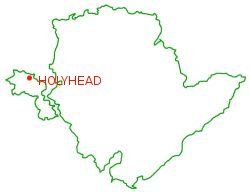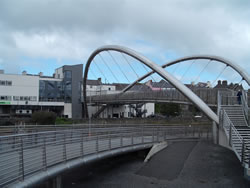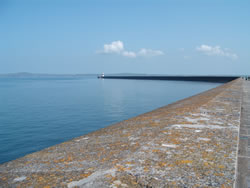Holyhead or Caergybi

Holyhead, the largest town on the island, is known as Caergybi in Welsh, which means the fort of Cybi, a Welsh saint. It had previously been known as Llan y Gwyddel, Eglwys y Bedd, and Cor Cuybi. In 1315, it was known as Haliheved, in 1536-39 The Holy Hedde, and in 1573, Holy Head or Caer Cybi. To the Romans, it was Sacrum Promentarium, which translates exactly as Holyhead. It is believed the name originally referred to the mountain which dominates this part of Anglesey. Note that Holyhead is always pronounced Hollyhead.
George Borrow, in his famous book 'Wild Wales, Its People, Language and Scenery' wrote about his visit to Holyhead in 1854 in these words.
"Caer Gybi, or Cybi's town is situated on the southern side of a bay on the north-western side of Anglesey. Close to it on the south-west is a very high headland called in Welsh Pen Caer Gybi or the head of Gybi's city, and in English Holy Head.... It is called Cybi's town from one Cybi, who about the year 500 built a college here to which youths noble and ignoble resorted from near and far."
 Holyhead owes much of its existence to the fact that, at the start of the 19th century, it was chosen for the strategically important port linking London and Dublin (Ireland). It marks the end of the historic A5 trunk road from London, which was designed by the famous engineer, Thomas Telford. It is best known as a point of arrival or departure from and to the republic of Ireland, being synonymous with ferry travel, and it is now the third busiest port in the United Kingdom after Dover and Felixstowe. Its position as the principal port of North Wales was initially in doubt when a route to Ireland was first proposed, as the first choice was the now quiet Morfa Nevyn on the Lleyn Peninsula. It was thought this was a better route as it did not require a crossing of the Menai Straits, which at this time had yet to be bridged. However, Thomas Telford's Menai suspension bridge, erected in 1826, meant that the Straits were no longer an obstacle to commercial travel. From then on, Holyhead's pre-eminence was assured, and it has remained unchallenged for nearly 200 years.
Holyhead owes much of its existence to the fact that, at the start of the 19th century, it was chosen for the strategically important port linking London and Dublin (Ireland). It marks the end of the historic A5 trunk road from London, which was designed by the famous engineer, Thomas Telford. It is best known as a point of arrival or departure from and to the republic of Ireland, being synonymous with ferry travel, and it is now the third busiest port in the United Kingdom after Dover and Felixstowe. Its position as the principal port of North Wales was initially in doubt when a route to Ireland was first proposed, as the first choice was the now quiet Morfa Nevyn on the Lleyn Peninsula. It was thought this was a better route as it did not require a crossing of the Menai Straits, which at this time had yet to be bridged. However, Thomas Telford's Menai suspension bridge, erected in 1826, meant that the Straits were no longer an obstacle to commercial travel. From then on, Holyhead's pre-eminence was assured, and it has remained unchallenged for nearly 200 years.
Holyhead's roots go back much further, and there is evidence of neolithic occupation in the area around South Stack. Further information on the Ty Mawr Hut Circles can be found on our Anglesey Archaeology pages. More recent was the occupation by the Romans, who constructed a hill fort on Holyhead Mountain. This fort was ancillary to the larger fort of Segontium (Caernarfon).
 The seaward side of the town is dominated by the breakwater. This took 28 years to build, and was completed in 1873. It is possible to walk its entire 1.5 mile length, although this is not recommended in high winds as waves can top the breakwater. The breakwater shields an area in excess of 660 acres, providing abundant safe mooring for both pleasure and commercial craft. It has a marina at its western end, and there are plans to create a new marina further along Newry Beach.
The seaward side of the town is dominated by the breakwater. This took 28 years to build, and was completed in 1873. It is possible to walk its entire 1.5 mile length, although this is not recommended in high winds as waves can top the breakwater. The breakwater shields an area in excess of 660 acres, providing abundant safe mooring for both pleasure and commercial craft. It has a marina at its western end, and there are plans to create a new marina further along Newry Beach.
The breakwater was constructed from stones quarried from Holyhead Mountain, and transported to the site by rail. The quarry area has in more recent times been transformed into the Breakwater Country Park, a peaceful haven with a small pool, with wheelchair access around it. The pool is popular with model boat enthusiasts on Wednesdays and Sundays, and with anglers, although fishing permits are required.
Ucheldre Centre, Holyhead
On the landward side, Holyhead's community and arts centre, Canolfan Ucheldre, features prominently. The meaning of Ucheldre is high town, and the name reflects the fact that the building is in the upper part of Holyhead. The Canolfan Ucheldre is all that is left of the French Roman Catholic convent for the order of the sisters of Bon Sauveur, and is in what was the former convent chapel.
The centre includes exhibition halls, an amphitheatre, a shop and a restaurant. The most striking feature of the main hall is the air of serenity that seems to speak of a much older building, when in fact the hall dates from the 1930s.
The restaurant is also of architectural interest with its use of massive Scandinavian curved pine beams. A doorway from the restaurant leads to a secluded garden, where some features from the original convent have been imaginatively incorporated into the overall scheme. A fountain sculpture "The Beginning of Life" is a particular feature.
In the grounds, there is another work of art, a sculpture of a pole vaulter, representing a leap into the future perhaps, or Welsh aspirations. Details of the many and varied events staged at the Ucheldre are on the centre's website, www.ucheldre.org/.
